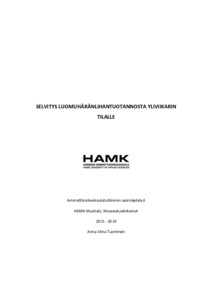Selvitys luomuhäränlihantuotannosta Yliviikarin tilalle
Tuominen, Anna-Stina (2019)
Tuominen, Anna-Stina
2019
All rights reserved. This publication is copyrighted. You may download, display and print it for Your own personal use. Commercial use is prohibited.
Julkaisun pysyvä osoite on
https://urn.fi/URN:NBN:fi:amk-2019052311471
https://urn.fi/URN:NBN:fi:amk-2019052311471
Tiivistelmä
Opinnäytetyön tavoite on selvittää luomuhäränlihan tuotantomahdollisuudet Yliviikarin tilalle. Yliviikarin tila on 45 lehmän luomumaitotila. Tavoitteena on selvittää saisiko tila lisätuloja kasvattamalla omat sonnivasikat kastroituna teurasikään asti omalla tilalla. Häränliha myytäisiin osaksi tilalta ja osaksi teurastamon kautta mahdollisuuksien mukaan.
Suomalaisia teurastuloksia häristä ei ole, joten työssä on käytetty muutamia ulkomaalaisia tutkimuksia. Kastraation eri vaihtoehtoja on pohdittu muutaman tutkimuksen perusteella. Eri vaihtoehtoja on siinä, missä iässä kastrointi kannattaa tehdä ja tehdäänkö se esimerkiksi kumilenkillä surkastuttamalla vai kirurgisesti leikkaamalla. Parhaaksi vaihtoehdoksi osoittautuu mahdollisimman nuorena tehty kastraatio kirurgisesti. Tällöin vältytään myöhäisen kastraation aiheuttamalta stressiltä, joka näkyy huonompana kasvuna kastraation jälkeen.
Laidunnus on olennainen osa härkien kasvatusta. Opinnäytetyössä on kerrottu, mikä olisi paras tapa hyödyntää juuri tämän tilan omia perinnebiotooppeja härkien laidunnuksessa. Paras tapa hyödyntää perinnebiotooppi on rotaatiolaidunnus.
Härät kasvavat huonommin kuin sonnit, mutta paremmin kuin hiehot. Laskelmat on tehty sen mukaan. Laskelmissa yksi härkä painaa oletetussa 20 kuukauden teurasiässä 620 elopainokiloa. Yhdestä härästä saa 48 %:n teurasprosentilla 298 kiloa lihaa. Myymällä siitä 17 % suoramyyntinä tilalta tulee yhden härän tulokseksi vajaa 2500 euroa. Tämä tulos ei tee härkien kasvatusta kannattavaksi. The goal of this thesis is to find out the possibilities of organic dairy steer production for Yliviikari farm, which is an organic dairy farm of 45 cows. The goal is to find out whether it is possible for the farm to earn extra income by raising their castrated bull calves on the farm until the calves are old enough to be slaughtered. The meat would be sold partly from the farm and partly from a slaughterhouse, if possible.
There are no results on slaughtering steers made in Finland and therefore this thesis includes a few foreign studies. Different choices of castration are considered based on a few studies. Choices are relevant when it is time to castrate and how to do it. The best choice is to surgically castrate as young as possible. This prevents the stress caused by castration at an older age which shows as a poor growth after castration.
Grazing is an essential part of raising steer. This thesis shows which would be the best choice to exploit the farm’s traditional biotopes for steer grazing. The best choice to use traditional biotope is rotational grazing.
Steers grow worse than bulls but better than heifers and the calculations are made based on this assumption. In the calculations one steer weighs at expected 20 months slaughtering age 620kg live weight. One steer produces 298kg of meat with 48% slaughtering percentage. If 17% of the meat is sold directly from the farm, then one steer’s profit is 2500€. The result does not make raising steer profitable.
Suomalaisia teurastuloksia häristä ei ole, joten työssä on käytetty muutamia ulkomaalaisia tutkimuksia. Kastraation eri vaihtoehtoja on pohdittu muutaman tutkimuksen perusteella. Eri vaihtoehtoja on siinä, missä iässä kastrointi kannattaa tehdä ja tehdäänkö se esimerkiksi kumilenkillä surkastuttamalla vai kirurgisesti leikkaamalla. Parhaaksi vaihtoehdoksi osoittautuu mahdollisimman nuorena tehty kastraatio kirurgisesti. Tällöin vältytään myöhäisen kastraation aiheuttamalta stressiltä, joka näkyy huonompana kasvuna kastraation jälkeen.
Laidunnus on olennainen osa härkien kasvatusta. Opinnäytetyössä on kerrottu, mikä olisi paras tapa hyödyntää juuri tämän tilan omia perinnebiotooppeja härkien laidunnuksessa. Paras tapa hyödyntää perinnebiotooppi on rotaatiolaidunnus.
Härät kasvavat huonommin kuin sonnit, mutta paremmin kuin hiehot. Laskelmat on tehty sen mukaan. Laskelmissa yksi härkä painaa oletetussa 20 kuukauden teurasiässä 620 elopainokiloa. Yhdestä härästä saa 48 %:n teurasprosentilla 298 kiloa lihaa. Myymällä siitä 17 % suoramyyntinä tilalta tulee yhden härän tulokseksi vajaa 2500 euroa. Tämä tulos ei tee härkien kasvatusta kannattavaksi.
There are no results on slaughtering steers made in Finland and therefore this thesis includes a few foreign studies. Different choices of castration are considered based on a few studies. Choices are relevant when it is time to castrate and how to do it. The best choice is to surgically castrate as young as possible. This prevents the stress caused by castration at an older age which shows as a poor growth after castration.
Grazing is an essential part of raising steer. This thesis shows which would be the best choice to exploit the farm’s traditional biotopes for steer grazing. The best choice to use traditional biotope is rotational grazing.
Steers grow worse than bulls but better than heifers and the calculations are made based on this assumption. In the calculations one steer weighs at expected 20 months slaughtering age 620kg live weight. One steer produces 298kg of meat with 48% slaughtering percentage. If 17% of the meat is sold directly from the farm, then one steer’s profit is 2500€. The result does not make raising steer profitable.
